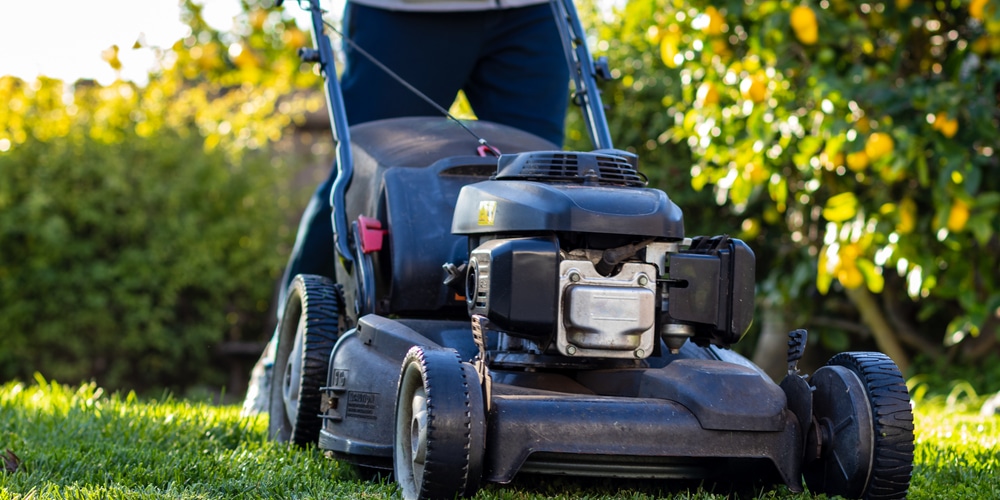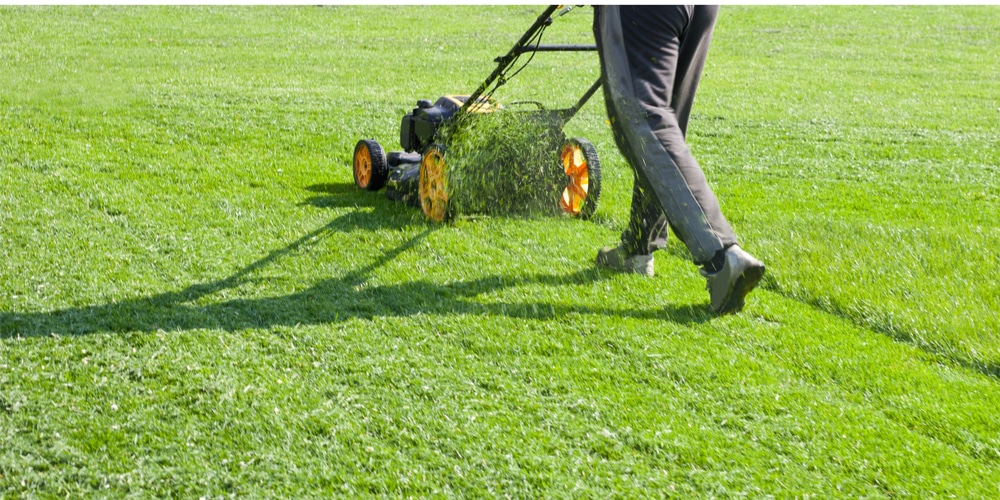Your Lawn’s Spring Needs
When the winter chill subsides, your lawn awakens with specific requirements to bounce back robustly.
- Climate Impact: Your local weather patterns significantly influence when to begin lawn care.
- It’s vital for the grass to be dry, and for daytime temperatures to consistently hit at least 40°F, as suggested by experts at Real Homes.
- Grass Growth: Watch for grass that’s grown at least 3 inches tall before considering the first cut.
- Active growth is a clear sign your lawn is ready to be mowed.
- Soil Condition: The soil should be completely thawed with a temperature above 50°F.
- Mowing on partially frozen ground can harm your lawn’s roots, as concluded by professionals consulted by Gardening Know How.
Here’s how to gauge the right time:
- Inspect the Terrain: Ensure the ground is firm, with no remaining frost patches.
- Check the Height: Grass should stand taller than usual mowing height, indicating vitality.
- Test the Soil: If possible, measure the soil temperature to ensure it’s warm enough.
Remember to adjust your mower to a higher setting for the first mow – cutting too short can stress the grass.
For more on ideal cutting heights, refer to the advice from Lawn Mower Guru.
Optimal Timing for Spring Lawn Mowing
Determining the best time to start mowing your lawn in spring hinges on several factors, including your local climate, the type of grass you have, and the condition of the soil.
Regional Climate Considerations
- Climate is key: Begin mowing when your region’s temperatures consistently stay above 40 degrees Fahrenheit.
- Lawns in cooler areas may have to wait longer to recover from frost.
- Avoid frost: To prevent grass damage, mow only after the frost has lifted and the temperatures support grass growth.
Grass Type Variations
- Different grasses, different needs: Grasses like Perennial Ryegrass usually need to be maintained at 2-3 inches, whereas Bermudagrass thrives at a shorter height of ½-1 inch.
- Warm-season vs cool-season: Warm-season grasses generally require you to wait until temperatures rise above 65°F, while cool-season grasses can start being cut earlier in spring when temperatures are mildly warm.
Soil Condition Readiness
- Check the ground: Your soil needs to be completely thawed; if it’s still cold or soggy, it’s too early to mow.
- Soil temperature matters: Ideally, wait for the soil temperature to rise above 50°F for cool-season grasses, as this signals that your lawn is emerging from its dormant phase.
Preparing Your Lawn Mower for Spring
With the arrival of spring, it’s crucial to get your lawn mower in top shape to ensure a smooth start to the mowing season.
Proper maintenance will prolong the life of your mower and improve the health of your lawn.
Maintenance Checklist
Before you start mowing, take time to perform a thorough maintenance check to ensure your lawn mower is safe and efficient.
- Check the oil: Measure the oil level and top up if necessary. If the oil is old or dirty, replace it.
- Inspect the air filter: A clean air filter is essential for the engine to run efficiently.
- Look over the fuel system: Old fuel can cause problems, so empty out last season’s gas and refill with fresh fuel.
- Examine the spark plug: A corroded spark plug can hinder performance. Replace it if it looks worn out.
Blade Sharpening
A dull blade tears grass, creating a jagged and uneven cut, which can make your lawn susceptible to diseases.
- Remove the blade: Ensure the mower is off and safely disconnect the spark plug before removing the blade.
- Sharpen the blade: Use a mill file or a bench grinder, following the original angle of the edge.
- Balance the blade: Ensure that each side of the blade weighs the same to avoid vibrations when running the mower.
Mower Cleaning
Debris and grass build-up can lead to rust and hinder your mower’s performance.
- Clear the undercarriage: Scrape off grass and mud from the mower deck to prevent clogging.
- Wipe down the exterior: Use a damp cloth to clean the top and sides of the mower.
- Lubricate moving parts: Apply an appropriate lubricant to wheels and cables to prevent wear and tear.
Mowing Techniques for Healthy Spring Growth
Proper mowing techniques in the spring are crucial for revitalizing your lawn and encouraging healthy growth.
As the season progresses, adjustments in mowing height and clipping management play a pivotal role in lawn care.
Mowing Height Adjustments
- Start Higher, Then Lower: Initially, mow at a higher setting to avoid cutting more than one-third of the grass height.
- This can foster root development and discourage weeds. As the season advances and the grass establishes, gradually reduce the mowing height.
- Grass Species Matters: Know your grass type. Cool-season grasses thrive around 2.5 to 3.5 inches, while warm-season grasses often do best slightly shorter.
Clipping Management
- Clippings as Nutrients: Leave the clippings on the lawn when you can, as they provide valuable nutrients back to the soil which can reduce the need for additional fertilizers.
- Regular Maintenance: If the accumulated clippings are too thick, they risk smothering the grass beneath.
- In such cases, occasionally remove excessive clippings to maintain lawn health.
Aftercare Following Initial Spring Mow
Immediately after the first spring mow, proper aftercare is crucial to ensure your lawn recovers and thrives.
This involves specific watering practices and fertilization strategies to promote healthy growth.
Watering Practices
- Frequency: Aim to water your lawn deeply but infrequently. This encourages deeper root growth.
- Morning Watering: The best time to water is in the early morning, as it reduces evaporation and fungal growth.
Consider the following factors to determine the right watering schedule:
- Soil Type: Clay soils require less frequent watering than sandy soils.
- Weather Conditions: Adjust your watering based on rainfall; overwatering can be as harmful as underwatering.
Fertilization Strategies
- Test Soil First: Before you fertilize, test your soil to determine what nutrients are needed.
- Slow-Release Fertilizers: Opt for slow-release fertilizers to provide a steady supply of nutrients.
Bullet points for effective fertilization:
- Apply fertilizer when your lawn is dry, and then water lightly to help it absorb.
- Follow the recommended rates on the fertilizer packaging to avoid overfeeding and damaging your lawn.
Frequently Asked Questions
When the snow has melted and the sun peeks through, it’s time to consider lawn care. It’s critical to time your lawn’s first cut of the season to pave the way for a lush, healthy summer lawn.
What factors determine the best time to start mowing the lawn after winter?
- Your location and the local climate play significant roles.
- The condition of your lawn and grass length are essential pointers; grass should be at least 3 inches tall before the initial mowing.
What is the recommended frequency for mowing the lawn during the spring season?
- Adjust the mowing frequency based on grass growth rate, which can be influenced by weather patterns.
- As a general rule, aim to cut only the top third of the grass blades at any mowing session.
How do I know when my lawn is ready for the first cut of the year?
- Check that the ground is thawed entirely.
- Also, make sure that soil temperatures have risen above 50°F.
- Look for consistent grass growth and sufficient height, indicating it’s time for the lawn’s first trim.
What are the guidelines for mowing the lawn with respect to local noise ordinances?
- Verify local noise regulations to determine acceptable mowing times.
- Typically, early mornings and late evenings might be restricted to minimize disturbance.
How can weather conditions affect the timing of the first lawn mowing in spring?
- Avoid mowing when there’s frost, as it can harm the grass—wait for the temperature to be consistently above 40 degrees F.
- Excessive moisture or a soggy lawn can also dictate when it’s safe to mow without damaging the turf.
What is the impact of mowing the lawn too early in the season?
- Mowing too soon can lead to turf damage and increased vulnerability to diseases.
- Premature mowing can also compact the soil or create ruts if the ground is still soft from thawing.
Last update on 2025-06-06 / Affiliate links / Images from Amazon Product Advertising API




